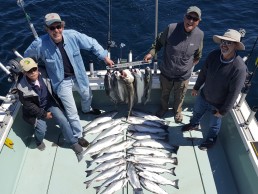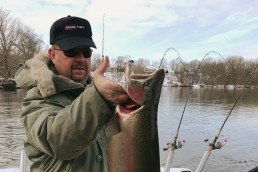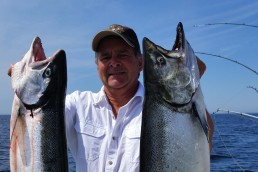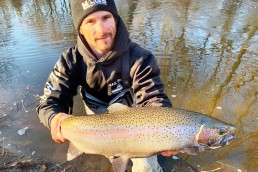Capt. Lee Haasch is Chasing Steelhead
SHARE THIS POST
The clouds to the west hid the quarter moon, but the sky to the east was absent of cover, letting the stars sparkle. Light, southerly breezes gave a strange hint of warmth. It will be another hot day on the pond. I untied the last line and gave us a big shove from the dock, and I felt Trevor slide the boat into gear and point us to the lighthouse. “Let’s head back to our track from yesterday; we can set in about 100 and follow our lines out, and those steelies should be in that same area,” I shouted to Trevor. I checked over our lineup of baits and chatted with our customers. It wasn’t long before Trevor powered us down and got us into trolling speed.
I dropped my inside Slide Diver with a flasher and fly setup. Next was the high Slide Diver with a blinking B & E spoon. The little LED blinking, colored light is a powerful attractant in low-light conditions and works well all day long.
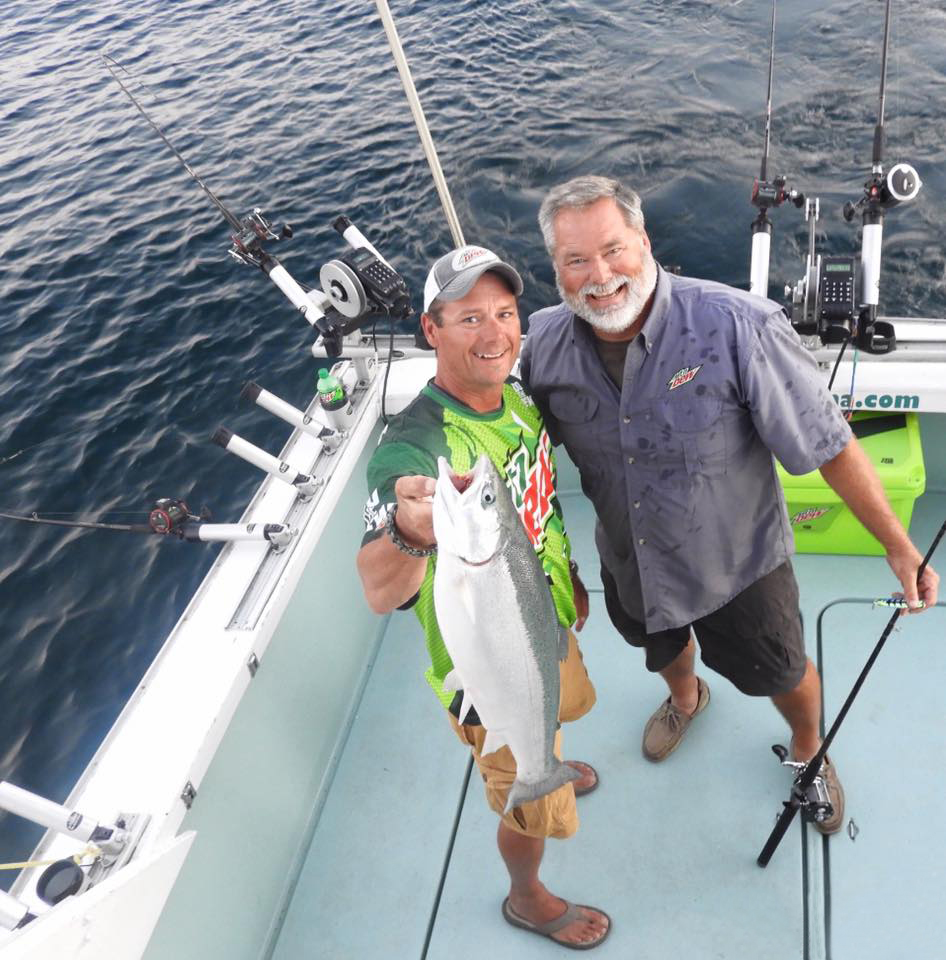
I had just set that Ugly Stik in the rod holder when Trevor shouted, “Fish on! Grab your diver.” That didn’t take long! My Ugly Stik was pounding towards the water and the drag was screaming. “Who’s up?” I shouted as I handed the pole off to my customer. “I’ll keep setting lines Trev; you take the fish,” I instructed.
Trevor cleared the back and, as he reached for the net, he yelled out, “Another fish! Who’s up?” And he grabbed the pounding rod working the front end of my blinky spoon. “Here it goes again! That one was hot yesterday!” he added. Minutes later, he slid the net under a feisty 17-pound king salmon and flopped it on the deck, and then turned to scoop a nice lake trout to complete the double.
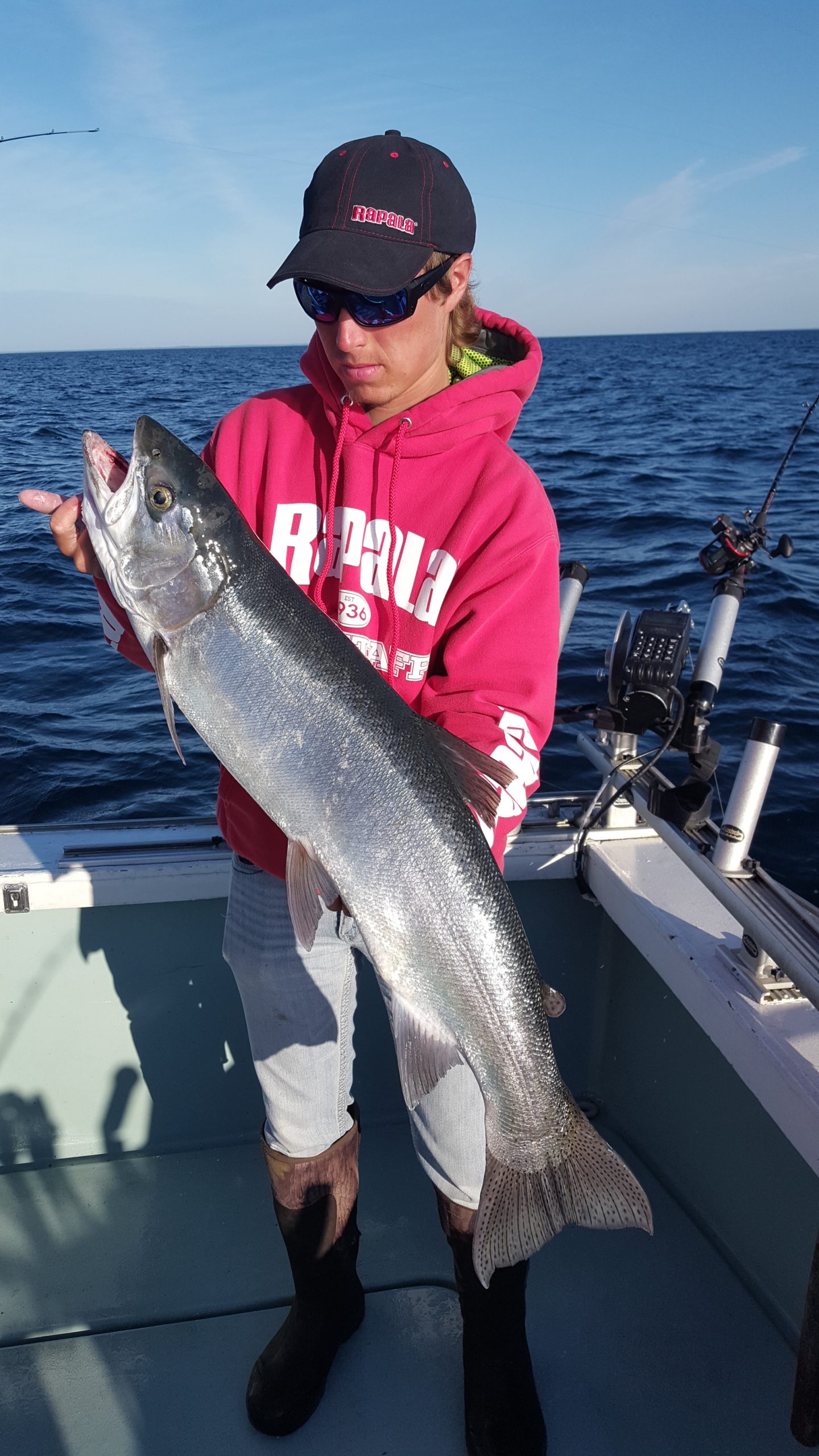
Furiously fast is the trademark of spring fishing. Early mornings often deliver a mixed bag of salmon and trout. Once the lake turns over in spring (warm water rises to the surface and cooler water sinks to the bottom), thermoclines start to set up. The sun warms the surface water on calm days and further helps to set more distinct temperature breaks. The warm-water side of the breaks will attract and hold more baitfish, and that attracts the hungry king salmon and steelhead. They’re perfect ambush sites to target. Following these breaks from day to day help you to stay on the fish.
Steelhead were on our minds this morning and it wasn’t long before we ran into some. The sun had popped above the horizon sometime during that last little flurry of activity, and the clear skies made for dark shadows cast on the deck, mimicking our every movement. “Fish on! Five-color; look at him jump!” Trevor shouted. It was on. The first steelhead of the day was dancing at the end of our far line and the anglers were in awe and counting the jumps—six, seven, eight—with everyone cheering in total awe of the dancing acrobatics. Minutes later, Trevor stabbed the net under the sleek steelie.
Setting up and following the thermoclines and crisscrossing back and forth over those temperature breaks establishes a good pattern for hungry fish. While king salmon are tops with most anglers, steelhead are a close second. And as excitement goes, maybe ranks even higher among anglers that witness the dancing and flopping that goes along with the fight to land one of these powerful tail-dancers. After all, fishing is all about the thrill of the battle, and it doesn’t hurt that the fillets make some of the best grilling fare. That excitement of watching your quarry as you do battle is something that is hard to beat.
Steelhead are mostly sight feeders. These fast-swimming torpedoes can cover a lot of water in no time and are consistently attracted by the flash of the lure. I like to target them in the top 25 feet of the water column. This is where they will spend the majority of their feeding time, targeting younger alewives that tend to feed near the surface. And as older alewives weaken, they also make their way up in the water column and become a sizable meal for steelhead.
Are you enjoying this post?
You can be among the first to get the latest info on where to go, what to use and how to use it!
Steelies also like to surface feed on bugs that accumulate on temperature breaks that we call slick lines or scum lines. Targeting these areas by weaving back and forth along these lines is a very productive and visible way to fish steelies.
Spoons are undoubtedly the number one go-to bait to catch steelhead. I have found that lures that have shades in the red spectrum are most effective. Silver spoons with red, pink and orange combined with silver, yellow or pearl entice strikes. Just as effective as the silver flash are spoons with the blinking LED lights in the eyes—anything that attracts the fish’s attention and triggers a strike. I tend to drag the lighter, shinier baits on sunny days and darker, more colorful baits on overcast or darker days. Also, because these powerful fish are such fast swimmers, when pulling more spoons, which are very speed forgiving, I found that picking up your speed and covering more water will increase your catch.
June is a great time to target steelhead as the surface water warms up from the colder winter months. As a bonus, we tend to see the coho salmon making their way up the shoreline as the water warms, and that makes for a great mixed bag in the cooler. So, turn up the speed, drag some orange and red spoons, and get ready to experience some tail-dancing, acrobatic leaping steelhead action—and fill your cooler with some of the tastiest grilling fare you will catch this summer!

Tip of the month
There is and art to targeting steelhead. The secret is to “spread your baits out.” To do that, I run in-line planer boards like Yellow Birds. I run medium-size boards closer to the boat to pull weighted rigs with 8- or 10-ounce weights. I run those sets a little deeper for king salmon or deeper steelhead. As my boards get wider, the sets get higher in the water column, ending with smaller boards that are pulling sets with very little weight and running highest in the water column. Often, these outside lines will be the most effective and get the most strikes.
One reason for this is, as the boat moves across the water, the steelhead being so high in the water column will swim wide from the boat as it approaches. These wide planer board spreads rack lures right in front of those fish. Without the wide spreads, targeting fish swimming and feeding higher in the water column would be very difficult to catch because they will simply miss your presentations. So, this summer, “Board up,” and fill up your cooler!
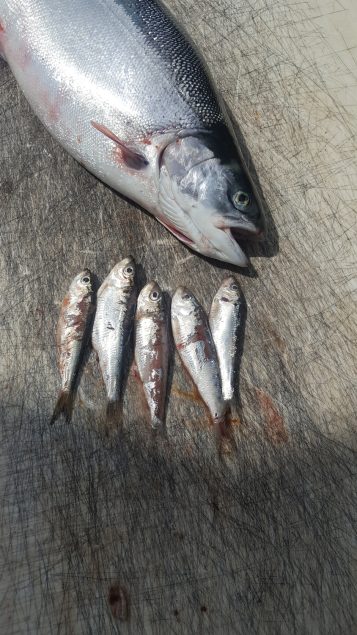
MWO
SHARE THIS POST
Did you enjoy this post?
You can be among the first to get the latest info on where to go, what to use and how to use it!
Lee Haasch
Capt. Lee Haasch is a charter captain out of Algoma, Wis., with more than 45 years of Great Lakes angling and guiding experience. Haasch has been instructing anglers for over 30 years with education seminars and timely freelance articles.
